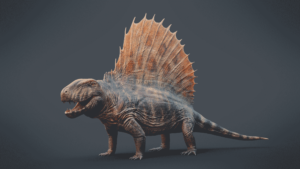Dimetrodon
- When: Permian
(295–272 mya) - Where: North America
- What: Synapsid
- Weight: 250–300 kg
- Length: 3–4.6 meters
- Diet: Carnivorous
- Discovered: 1878
The Permian Period: A World of Ancient Supercontinents
Step into the Permian Period, a time from about 298 to 252 million years ago when Earth’s landmasses were clustered together into the supercontinent Pangaea.
The Permian Period is the final period of the Paleozoic Era and a pivotal time in Earth’s history.
It saw the continuation of diverse marine life, including giant sharks and amphibians, while early reptiles began to dominate the land.
Iconic creatures like Dimetrodon with its sail-like back and the powerful herbivore Edaphosaurus roamed the landscapes. Plant life flourished, with forests of ferns and early conifers covering the continents.
The Permian Period also witnessed dramatic climate changes and the evolution of complex ecosystems, setting the stage for the Mesozoic Era to come. However, it ended with the devastating Permian-Triassic extinction event, wiping out around 90% of marine species and 70% of terrestrial species, marking the Earth’s most severe mass extinction.
The Permian Period was a time of both flourishing life and cataclysmic change, shaping the course of evolution on our planet.
